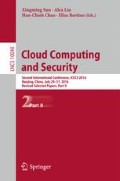Abstract
This paper focuses on human facial expression recognition in video sequences. Different from the methods of two-dimensional image recognition and three-dimensional spatial-temporal interest point detection, our approach highlights human facial expression recognition in complex spatial-temporal video datasets. The major challenge in facial expression recognition is how to obtain a feature dictionary from extracted cube pixel windows based on clustering algorithm. In this paper, our contributions are mainly concentrated on two aspects. Firstly, we combine discrete linear filter with key parameters selection procedure to extract 3D cuboids. Secondly, we propose a novel seed spot selection method to optimize K-means clustering algorithm. The proposed algorithms are evaluated on open databases. The results show that our approach can achieve outstanding results and the proposed approach is significantly effective.
Access this chapter
Tax calculation will be finalised at checkout
Purchases are for personal use only
References
Ali, S., Shah, M.: Human action recognition in videos using kinematic features and multiple instance learning. IEEE Trans. Pattern Anal. Mach. Intell. 32(2), 288–303 (2010)
Wu, B., Yuan, C., Hu, W.: Human action recognition based on context-dependent graph kernels. In: Proceedings of the IEEE Conference on Computer Vision and Pattern Recognition (CVPR), pp. 2609–2616. IEEE (2014)
Lin, Y., Hua, J., Tang, N., Chen, M., Liao, H.: Depth and skeleton associated action recognition without online accessible rgb-d cameras. In: Proceedings of the IEEE Conference on Computer Vision and Pattern Recognition (CVPR), pp. 2617–2624. IEEE (2014)
Kantorov, V., Laptev, I.: Efficient feature extraction, encoding and classification for action recognition. In: Proceedings of the IEEE Conference on Computer Vision and Pattern Recognition (CVPR), pp. 2593–2600. IEEE (2014)
Zhang, B., Perina, A., Li, Z., Murino, V., Liu, J., Ji, R.: Bounding multiple gaussians uncertainty with application to object tracking. Int. J. Comput. Vision 118(3), 364–379 (2016)
Du, Y., Wang, W., Wang, L.: Hierarchical recurrent neural network for skeleton based action recognition. In: Proceedings of the IEEE Conference on Computer Vision and Pattern Recognition (CVPR), pp. 1110–1118. IEEE (2015)
Zhang, H., Zhou, W., Reardon, C., Parker, L.: Simplex-based 3D spatio-temporal feature description for action recognition. In: Proceedings of the IEEE Conference on Computer Vision and Pattern Recognition (CVPR), pp. 2059–2066. IEEE (2014)
Zhang, B., Li, Z., Perina, A., Del Bue, A., Murino, V.: Adaptive Local Movement Modelling (ALMM) for object tracking. IEEE Trans. Circuits Syst. Video Technol. 99(1051–8215), 1 (2016)
Wang, J., Wu, Y.: Learning maximum margin temporal warping for action recognition. In: Proceedings of the IEEE Conference on Computer Vision and Pattern Recognition (CVPR), pp. 2688–2695. IEEE (2013
Ballas, N., Yang, Y., Lan, Z., Delezoide, B., Preteux, F., Hauptmann, A.: Space-time robust representation for action recognition. In: Proceedings of the IEEE International Conference on Computer Vision (ICCV), pp. 2704–2711. IEEE (2013)
Zheng, J., Jiang, Z.: Learning view-invariant sparse representations for cross-view action recognition. In: Proceedings of the IEEE International Conference on Computer Vision (ICCV), pp. 3176–3183. IEEE (2013)
Tulsiani, S., Malik, J.: Viewpoints and keypoints. In: Proceedings of the IEEE Conference on Computer Vision and Pattern Recognition (CVPR), pp. 1510–1519. IEEE (2015)
Laptev, I.: On space-time interest points. Int. J. Comput. Vision 64(2), 107–123 (2005)
Dollár, P., Rabaud, V., Cottrell, G., Belongie, S.: Behavior recognition via sparse spatio-temporal features. In: Proceedings of the IEEE International Workshop on Visual Surveillance and Performance Evaluation of Tracking and Surveillance (PETS), pp. 65–72. IEEE (2005)
Lowe, D.: Distinctive image features from scale-invariant key points. Int. J. Comput. Vision 60(2), 91–110 (2004)
Yang, M., Zhang, L.: Gabor feature based sparse representation for face recognition with gabor occlusion dictionary. In: Daniilidis, K., Maragos, P., Paragios, N. (eds.) ECCV 2010. LNCS, vol. 6316, pp. 448–461. Springer, Heidelberg (2010). doi:10.1007/978-3-642-15567-3_33
Celebi, M., Kingravi, H., Vela, P.: A comparative study of efficient initialization methods for the k-means clustering algorithm. Int. J. Expert Syst. Appl. 40(1), 200–210 (2013)
Ghosh, S., Dubey, S.: Comparative analysis of K-means and fuzzy C-means algorithms. Int. J. Adv. Comput. Sci. Appl. 4(4), 34–39 (2013)
Wen, X., Shao, L., Xue, Y., Fang, W.: A rapid learning algorithm for vehicle classification. Inf. Sci. 295(1), 395–406 (2015)
Zheng, Y., Jeon, B., Xu, D., Wu, Q., Zhang, H.: Image segmentation by generalized hierarchical fuzzy C-means algorithm. J. Intell. Fuzzy Syst. 28(2), 961–973 (2015)
Gu, B., Sheng, V., Tay, K., Romano, W., Li, S.: Incremental support vector learning for ordinal regression. IEEE Trans. Neural Netw. Learn. Syst. 26(7), 1403–1416 (2015)
Zhang, B., Perina, A., Murino, V., Del Bue, A.: Sparse representation classification with manifold constraints transfer. In: Proceedings of the IEEE Conference on Computer Vision and Pattern Recognition (CVPR), pp. 4557–4565 (2015)
Li, J., Li, X., Yang, B., Sun, X.: Segmentation-based image copy-move forgery detection scheme. IEEE Trans. Inf. Forensics Secur. 10(3), 507–518 (2015)
Acknowledgements
This work was supported in part by the Natural Science Foundation of China under Contract 61272052, 61473086, 61672079 and 61601466, in part by PAPD, in part by CICAEET, and in part by the National Basic Research Program of China under Grant 2015CB352501. The work of B. Zhang was supported by the Program for New Century Excellent Talents University within the Ministry of Education, China, and Beijing Municipal Science & Technology Commission Z161100001616005.
Author information
Authors and Affiliations
Corresponding author
Editor information
Editors and Affiliations
Rights and permissions
Copyright information
© 2016 Springer International Publishing AG
About this paper
Cite this paper
Yang, Y., Yang, B., Wei, W., Zhang, B. (2016). Human Facial Expression Recognition Based on 3D Cuboids and Improved K-means Clustering Algorithm. In: Sun, X., Liu, A., Chao, HC., Bertino, E. (eds) Cloud Computing and Security. ICCCS 2016. Lecture Notes in Computer Science(), vol 10040. Springer, Cham. https://doi.org/10.1007/978-3-319-48674-1_32
Download citation
DOI: https://doi.org/10.1007/978-3-319-48674-1_32
Published:
Publisher Name: Springer, Cham
Print ISBN: 978-3-319-48673-4
Online ISBN: 978-3-319-48674-1
eBook Packages: Computer ScienceComputer Science (R0)

